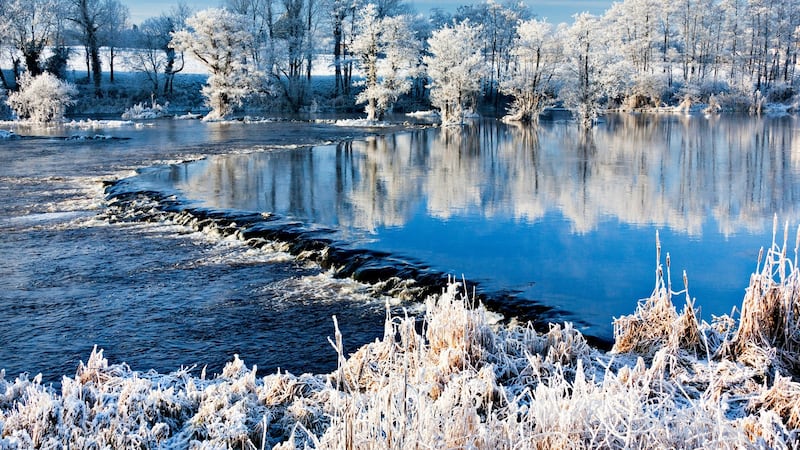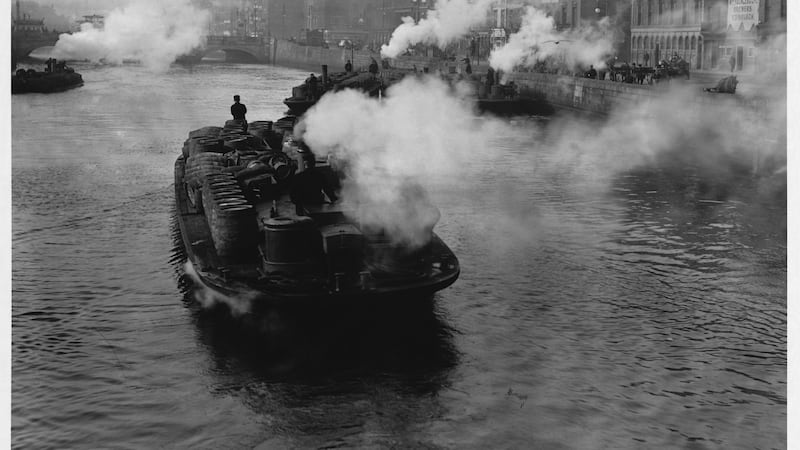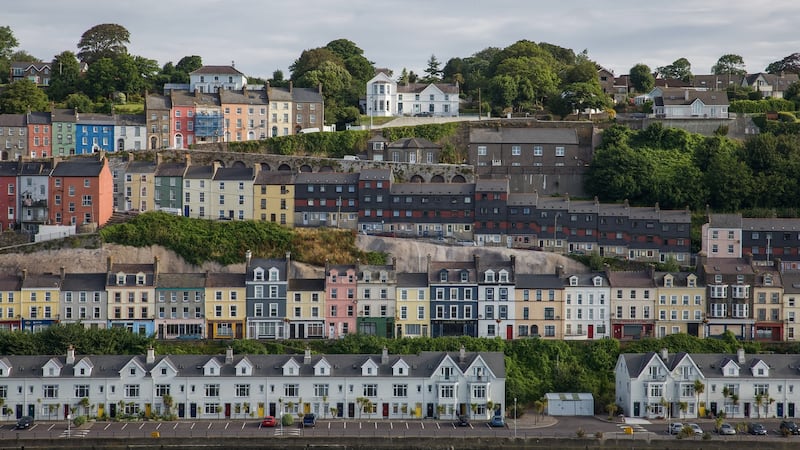For 10,000 years, human have used and abused Irish rivers. They need to be cared for if they are to recover from the worst effects of human intervention, according to a major new book, Ireland’s Rivers.
When Ireland separated from the rest of Europe, following the retreat of the ice some 10,000 years ago, the first humans arrived on the island. Those first inhabitants came by boat most likely via the narrow sea crossing from Scotland.
These Mesolithic people chose riparian and coastal areas for their settlement sites. A supply of fresh water was essential for survival and rivers provided drinking water as well as food in the form of aquatic plants, fish and wildfowl for these hunter-fishers.
Towards the end of the Mesolithic period, around 4000 BC, hunting and gathering had largely been replaced by farming and the domestication of animals, where proximity to watering areas was important. Ireland at that time was heavily wooded, mostly of oak, and the river margins were used for transport and communication.
Before the invention of the wheel, boats were important for the transport of goods as well as people. The earlier types were skin-covered but later, from the beginning of the Neolithic period (c. 3000 BC), log boats or dugouts, made from hollowing out a straight tree trunk, were used. By this time, following a period of wetter climate with warmer temperatures, the landscape had changed with the reformation of bogs from the shallow lakes.
The river water was used for washing and cooking and in the dyeing of garments. Tanning of animal skins, whereby the hide was thickened and hardened, was carried on anciently in Ireland and the tanned leather was used for various purposes – clothes, shoes and vessels for holding liquids, as well as covering for boats.
Archaeological evidence of burnt mounds, where stones were heated to boil the water, has shown that such troughs with associated stone heaps, also known as fulachtaí fia, were sited beside rivers and in use into the early Bronze Age (c. 2000 BC). Although now grassed over, more than 7,000 of these places have been identified around Ireland and explanations of their uses include cooking of food, extraction of tallow, dyeing cloth or wood, bathing and even spiritual associations.
Riverside camps were used when trapping fish during the migration seasons of the eel Anguilla anguilla and salmon Salmo salar. The hazelnut was a very important element of the diet as it could be stored and served as a reserve food for the winter and early spring before the first run of salmon in the rivers. Both these food items feature in Irish myth and legend, most notably the tale of Fionn and the Salmon of Knowledge from the River Boyne. This legendary warrior, Fionn Mac Cumhaill, is said to have been killed by a fisherman of the Boyne with his gaff.

Brú na Bóinne (the Bend of the Boyne), encompassing the area from the south-west of the river to the confluence with its tributary the Mattock in the north-east corner of the region, has been the focus of human settlement for at least 6,000 years. The selection of the site for settlement was likely influenced by the proximity to the river and its aquatic resources and nutrient-rich agricultural silts. With its numerous passage tombs – most notably the larger ones at Knowth, Newgrange and Dowth – the site contains one of the world’s most important prehistoric landscapes and was inscribed on the World Heritage List in 1993.
In Irish mythical tales Brú na Bóinne was one of the routes through which the spirits of the dead could enter the Otherworld or Tír na nÓg, the land of eternal youth; rivers were seen as sustaining life and were revered in death. Among the myths of the ancient Irish was the belief that all rivers flowed eventually to this Otherworld where they took a circuitous course before returning, and that mythical heroes could also enter this mysterious spiritual world when under water.
In one Celtic legend the origin of the 12 chief streams of Ireland was said to have been generated by a great hailstorm . We do not know to which these referred but the dozen longest rivers of today are the Shannon, Barrow, Suir, Blackwater, Bann, Nore, Suck, Liffey, Erne, Foyle, Slaney and Boyne.
The ancient bards of Ireland believed that there were fountains at the headwaters of the chief rivers over which grew hazel trees that produced nuts that turned red in autumn. Salmon and trout Salmo trutta travelled up the rivers to feed on the fallen nuts and this is said to have caused red speckles to appear on their bodies, and that anyone who caught and ate such fish would be endowed with poetic inspiration. This legend is a variation of Fionn and the Salmon of Knowledge also featuring hazel nuts and fish.
Also in Celtic legend rivers had feminine names in honour of the goddesses who ruled their catchments such as Bóand (Boyne), Lífe (Liffey) and Sínann (Shannon). Similarly, many rivers are named Clodagh or its variants Clodiagh, Clydagh and Clady, which are also said to be called after a female deity, although such names could also be associated with their being stony.
Pagan Celtic Ireland during the late Iron Age saw significant advances in travel and transport that included navigation of rivers.
Population and pollution
Primitive communities, living in small numbers, had little effect on the environment where sewage and other waste could be harmlessly absorbed by the rivers. Woodland was extensively cleared during the early Iron Age (c. 700 BC), which had an effect on river courses. At that time, the population was little more than 70,000 and even in the late Middle Ages the population of Ireland was most probably about ten times that figure, perhaps reaching the one million mark by the year 1600.
There had been a significant drop in population level in the period of 1348-1350 AD due to the bubonic plague, or the Black Death as it was commonly known. Later diseases as well as wars would also wipe out hundreds of thousands of people, such as the war beginning with the rebellion of 1641, which lasted for 11 years with the plague and famine that accompanied it.
Between 1700 and 1840 there was a huge increase in population, largely due to the effects of the earlier plantations of Ireland by English, Scottish and Welsh settlers. The number of people on the island of Ireland peaked at some eight million but a momentous decline, due to death and emigration, occurred following the Great Famine between 1845 and 1852 when the population was effectively halved.
Dublin had grown in population size from about 20,000 in 1650 to 130,000 by the 1750s while the population of Cork had increased from some 12,000 to around 70,000 in the same period.

From the 17th to the 19th century the urban houses built almost always faced away from the rivers, an indication that the authorities regarded them as convenient receptacles for waste. The population expansion of cities and towns created public health problems.
Cesspits in basements of establishments, such as army barracks, and private houses gave rise to foul smells and sometimes polluted the wells used for drinking water. They were associated with diseases such as cholera and typhoid and good ventilation as well as the introduction of earth closets were seen as the solutions.
Until the late 18th century Dublin had open drains into which chamber pots were emptied. Some properties relied on a garden cesspool, forerunner of the septic tank, where the sewage seeped into the ground.
Industrialisation and the expansion of towns occurred in the early 19th century, this dramatic increase in urban population put higher demands on the rivers. In 1872 a Dublin Sanitary Association had been formed to endeavour to clean the filth and degradation in the city. New sewers were constructed that carried waste directly to the Liffey, which then became highly polluted.
Municipal water supply for drinking, washing and toiletry had led to waste being directly discharged to rivers. The introduction of water closets with the associated sewer systems contributed to the problem. Conveniently out of sight, these were seen as cleaner than the systems that preceded them, indicating the priority of public health above environmental concerns.
The disposal of sewage to rivers by the sanitary authorities led to conflict with the fishery authorities, a situation that continued into the 20th century. For example, following a fish kill the Fishery Conservators took a case against the Corporation of Dublin in 1907 for pollution of the Liffey above Island Bridge and for which a fine of £3 was imposed.
Sewage discharges
Even up until some 30 years ago, rivers in or below many towns were grossly or moderately polluted for a short stretch that dissipated with travel downstream as the river acted as a wastewater treatment plant breaking down the sewage. The smell from the Lee in Cork city was immortalised in the modern local ballad, Boys of Fairhill, with its allusion to the statue of the temperance-reforming Capuchin priest Theobald Mathew (1790-1856):
The smell on Patrick’s Bridge is wicked.
How does Father Mathew stick it?
The long-standing smell in Dublin city also celebrated in song, Summer in Dublin, continued long after the cessation of sewage discharges until the closure of an industrial premises whose effluent to the culverted Camac River had discharged to the Liffey.
Nonetheless, the capital and second city have always had salmon running through their waters, which is a heritage that many other countries could only wish for. Belfast lost its salmon runs in the middle of the 18th century but following a steady increase in water quality and restocking of the Lagan these returned in the 1990s after an absence of more than two centuries.

During the 1980s many local authorities adopted water quality management plans, the first such plan being published 37 years ago in 1983 for the Barrow catchment with others following thereafter. One of the main outcomes of the plans was the commissioning of some new wastewater treatment plants. In the 1990s the EEC Urban Waste Water Treatment Directive came into force and has largely resulted in the elimination of serious sewage pollution in most urban areas.
Up until relatively recently slime growths, indicating grossly polluted conditions, were a common feature in Irish rivers downstream of many towns and near industrial locations and still occur occasionally, particularly where silage effluent reaches a river.
There is a long history of slime growths, due to sugar-beet waste discharges, in the River Barrow at and downstream of the Carlow sugar factory. They were first recorded in the river at the beet-sugar factory in the winters of 1927 and 1928. The sugar factory had been run as a private company from 1926. In 1934 Comhlucht Siúicre Éireann (CSE) was established and it bought out the interest in the Carlow factory and set up further facilities at Mallow on the Blackwater, Thurles on the Suir and Tuam on the River Clare. Large volumes of water were used in the processing of beet and for cooling purposes.
Beet was an important winter cash crop for many farmers and during the ‘beet campaign’ – usually October to February – when the sugar factory was processing the season’s crop many others were employed on a part-time basis. Because of low river temperatures slime growths could extend for tens of kilometres downstream. For unrelated reasons, all sugar beet production was shut down in Ireland in 2006.
Our rivers today
Ireland’s earliest inhabitants depended on rivers for water, food, transport and territory divisions. Through the ages, humans also harnessed rivers for power and exploited them for pearl mussels and gold and in recent times they have become increasingly important for recreation. Although most of these dependencies still exist, many rivers have become degraded from past and present pressures, such as pollution, arterial drainage and other channel modifications.
The recent water quality report from the Environmental Protection Agency highlights that, although serious pollution of Irish rivers remains low, there has been a further reduction in water quality, and the number of high-quality river sites continues to decline at an alarming rate. The major source of pollution is from agriculture. Plans to further intensify agriculture, particularly in regions where water quality is already impacted, will place additional pressures on river water quality and associated biodiversity.
The loss of high-quality sites has continued unabated for several decades so halting it now is a matter of great urgency and perhaps our greatest challenge and duty.
These sites are not only important for the biodiversity they support, but are also a source of species to repopulate rivers that are recovering from the effects of pollution. Point-source pollution with raw sewage unfortunately remains a problem in some urban centres.
There are some reasons for optimism, however: a growing awareness of water pollution in some communities and a willingness to seek solutions are seeds of hope that need to be supported.
By John Lucey. An edited extract from Ireland’s Rivers, by Mary Kelly-Quinn and Julian Reynolds, is published by UCD Press








